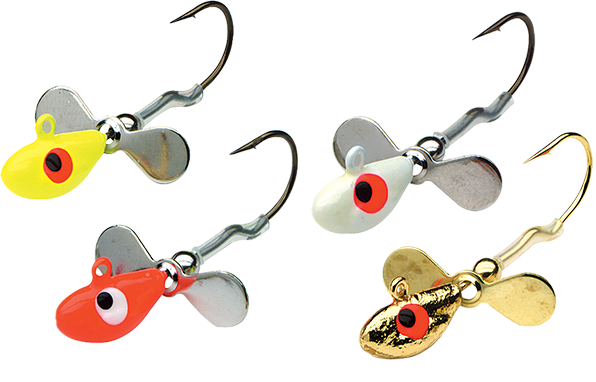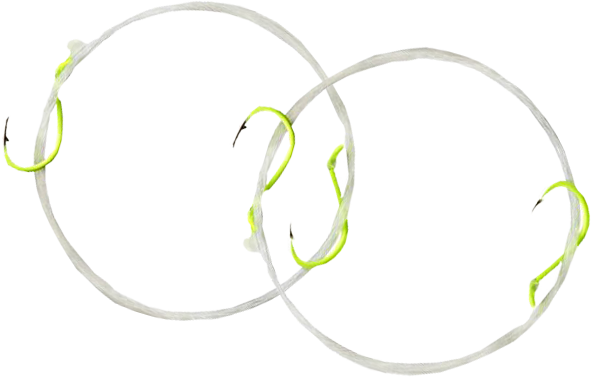Walleye

Characteristics

Walleye, a freshwater perch, are commonly referred to as pickerel in the prairie region. They have a long and thin body with predominantly gold or olive colouring and white belly.
Their backs are crossed with five or more black bands, and they have two dorsal fins. Walleyes have large mouths with sharp teeth, and extraordinary low-light vision that helps them find prey at night or in murkier waters.
The average size range for a catchable Walleye is between 12 and 24 inches and weighs between half a pound and 6 pounds with ‘trophy sized’ females commonly exceeding 30 inches and 10 pounds. One specimen in Dryden, Ontario exceeded 36 inches and 22 pounds.
Habitat

Walleyes are native to Canada. They are found in any of the Great Lakes and most major river systems across the central part of the country. These fish prefer cold water and are especially popular during the ice fishing season.
In many ways, Walleye fishing is a matter of understanding: water, temperature and presence of structure and baitfish.
Walleyes move to shallow flats during dawn and dusk to feed on baitfish such as yellow perch, large invertebrates, and insects.
Spring: When waters begin to be warm, Walleyes move into rivers to spawn. After spawning, they return to main waterbodies of lakes but remain near shore or around structures.
Late spring: As the water temperature rises, Walleye move into deeper waters and start to suspend as they follow baitfish.
Fall: As the water temperature declines, Walleyes move to shallower waters and stage off main lake points.
For catching Walleye, look for water temperatures and proximity to the structure. They are primarily nocturnal, moving out from the shelter of tree roots, logs, and aquatic plants to shallower waters at night.
Walleye Fishing Techniques
Bottom Bouncing
When fish are sticking close to the bottom, you’ll need to get your bait right in their face, which is where bottom bouncing becomes useful.
Though it’s not the most exciting method of fishing, it is effective. Bottom bouncers consist of a stiff wire with a glob of heavy metal (typically lead) that bounces along the bottom while avoiding snags and presenting your bait right in the strike zone. This technique is particularly useful when paired with a spinner rig.
Jigging

With this technique, it’s as simple as allowing your jig to reach the bottom or mid-water column (wherever the fish are holding), and then moving the jig up and down at varying speeds and motions, working the water column.
With a jigging technique, it’s important to have a strong rod with a quick tip, especially if you plan on reeling in larger fish. Most anglers recommend low-stretch line such as braid or fluorocarbon for maximum sensitivity and hook-setting abilities.
Cranking
This can refer to two different techniques:
The first involves repeatedly casting your rod, and quickly cranking your reel.
It’s recommended for more aggressive species that will be enticed by the challenge of quickly moving prey. When you’re fishing around cover, you should slow down your retrieve and/or slightly raise your rod, allowing your bait to pause. Experiment by stopping and starting your bait when you’re running your lure through open water, which may help trigger strikes from more sedentary fish. When you do get a bite, try to remember what exactly you were doing when the strike occurred and adjust your technique accordingly. If it worked once, chances are it will work again!
The second refers to trolling crankbaits at a specific depth where the target species is known to live.
For Walleye, this typically means close to the bottom in 15-30 feet of water or suspended mid-water column over deeper water (40+ feet). The size of the plastic lip on a crankbait dictates how deep the lure will run and most manufacturers will list a maximum diving depth and recommend the line distance required to hit that depth somewhere on their packaging.
Rigging

This technique incorporates a variety of items to assemble a fool-proof apparatus perfect for hooking Walleye.
There are several variations of rigs that can be built, but they all have one thing in common: they are assembled using combinations of various components including a main line and a leader line, weights, terminal hooks/floats, rod, reel, and bait. Essentially, this approach allows you to customize your gear to optimize your technique based on your desired results. The weight is utilized to keep your bait where the fish are biting. The leader line or snell length recommended varies greatly depending on the water clarity and fishing pressure the waterbody experiences, with some anglers swearing by 3-foot snells in murky, low pressure situations, and 8-foot snells in clear, high-pressure waters.
SHOREFISHING
You don’t always need a boat in order to bring in big fish. In fact, some extremely successful anglers prefer fishing alongside piers, riverbanks, and lake shores.
We recommend seeking out areas of shoreline with vegetation, logs, rock piles, steep drop-offs, downed trees and other submerged structures that act as a meeting place for fish to gather. The more remote the area, the better luck you’ll have because fish are deterred from too much activity or sound. Resist the urge to cast your line straight outward, as it’s better to have your line parallel to the shoreline, where most fish will be hanging out.
Effective Walleye Techniques Based on Seasons

Effective Walleye Techniques Based on Seasons
- Early Spring: This time of the year, Walleye fishing involves soft plastics, light tackle and jigs. Many anglers prefer spinning tackle, reels in the 1000-2500 class range spooled with either 4–8-pound mono or 8–10-pound braid.
- Early Summer: Target main lake points and structure near shore by using trolling crankbaits and bouncing bottom with live baits.
When using live bait for Walleye, use a sinker between ¼ to ⅛ of an ounce (depending on the current and depth) and a leader of 8-10-pound fluorocarbon or mono. You can also use a night crawler, minnow, or leech on a size six octopus hook. - Summer Walleye Fishing: As the water temperature rises, Walleyes move deeper. Trolling crankbaits allows you to cover a lot of ground, and because they begin to run in small groups of three or four, it becomes tricky to jig or live bait.
Using line counter trolling reels spooled with lead core line or braided line with snap-on weights or planer boards will substantially increase the trolling area behind your boat. - Fall Walleye: To locate Walleye in the fall, use your sonars to catch them jigging vertically or horizontally. Depending on the current and depth, the jigs and raps will range between size 3.8 and about an ounce. In shallow waters, jigs will range between 1/8 to 1/4. These will be larger for deep-water fishing applications. You can choose to live bait in the fall or use a jig head tipped with a live minnow.
- Winter Walleye Fishing: Like most fish, Walleyes migrate to deeper sections of the lake as the temperature drops. To fish Walleyes like a pro, use a perch pattern jig to match the prey in applicable lakes.
How to Choose Colours for Walleye Fishing
Walleyes are visual hunters that can see even in low light. They use their vision to detect prey and other various tasks. A study at Ohio State University confirmed that Walleyes strike white lures or almost any colour in clear waters while in sedimented waters, they preferred gold or yellow, and in green algal waters, Walleye eyes are best at recognizing black colour.
However, experimenting with different colours to see what works for your fishing conditions will always help you catch more fish.
What To Do When Walleyes Won't Bite
Weather plays a significant role in Walleye fishing.
- Walleyes have light-sensitive eyes that make overcast days perfect for fishing. On such days, Walleyes are more active and tend to feed and roam around.
- On windy days, the wave action breaks up sun protection and increases the chances of catching Walleye. However, these conditions may not be the best for anglers to fish.
- In a shallow, fertile lake on a sunny and still day, your best option is to search for the greenest, lush weeds available and present a jig to Walleye.
- These fish usually seek shade underneath the weeds. Using slow, methodical lifts of twistertail or bucktail will help to catch inactive Walleyes. Adding a minnow or worm to the jig will make them more responsive.
Tip: The more miserable the weather, the faster you should retrieve your jig. On beautiful sunny days, a slower presentation and added searching will help in finding inactive Walleyes.